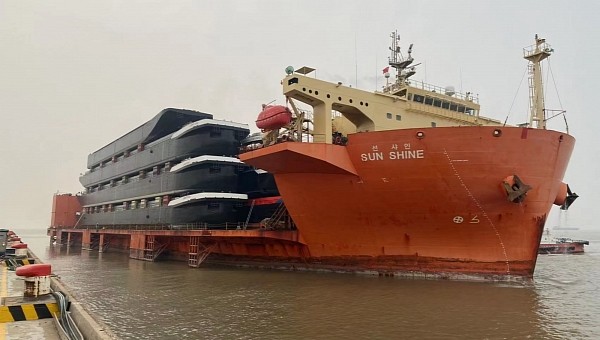The use of hydrogen for hybrid propulsion systems is one of the several approaches for reducing harmful emissions related to shipping. So far, its applications range from tugboats and small cargo ships (in combination with modern sailing systems) to catamarans and even powerboats. Another premiere will see the integration of a fuel cell propulsion system on an inland vessel, said to be the first of its kind in the world.
Antonie is the name of a brand-new cargo vessel that, in addition to conventional features such as a total length of 135 meters (443 feet) and a 3,700-ton cargo capacity, will boast something out of the norm. That is a fuel cell propulsion system, which will make Antonie the first inland ship (circulating only in inland waterways) to be fueled by hydrogen.
The pioneering watercraft is being outfitted by Concordia Damen in the Netherlands, where the hull is currently due to arrive from Shanghai. Once completed, it will enter service with Nouryon, a chemical supplier. As an inland vessel, Antonie will operate on a relatively short route between Delfzijl in the north of the Netherlands, and Botlek, in the Port of Amsterdam, carrying salt as its cargo.
But there’s an interesting story behind this particular operator and the future operating route. It all began almost a decade ago, in 2014, when two provinces in the north of the Netherlands, Groningen and Drenthe, obtained a subsidy from the Dutch government for hydrogen-powered vehicles. Not vessels, but buses.
The green hydrogen for the two buses in the pilot project would be supplied by the company we mentioned earlier, Nouryon. Operating as a chemical factory in the region, Nouryon could obtain hydrogen as a by-product of the chlorine-making process.
Another important part of this pilot project was the addition of a cost-effective hydrogen filling station in the same area. TotalEnergies was the company chosen to design, build, and operate the hydrogen bunker station that is still functioning to this day.
This is where we get back to the new Antonie vessel, which will not only be operated by the same chemical supplier that provides green hydrogen for the area, but will also benefit from the same hydrogen station that was originally built for the two buses.
The hydrogen-powered Antonie is also the result of governmental funding, as is often the case with clean energy projects in Europe. Concordia Damen, a shipyard with experience when it comes to hybrid-propulsion vessels, was selected to build the new ship back in 2021, by Lenten Scheepvaart.
Lenten Scheepvaart was the company that got a €4 million subsidy ($4.3 million) from the Netherlands Governmental department of Infrastructure and Water Management. The goal? To create a path for zero-emission inland shipping, with the help of green hydrogen.
The pioneering watercraft is being outfitted by Concordia Damen in the Netherlands, where the hull is currently due to arrive from Shanghai. Once completed, it will enter service with Nouryon, a chemical supplier. As an inland vessel, Antonie will operate on a relatively short route between Delfzijl in the north of the Netherlands, and Botlek, in the Port of Amsterdam, carrying salt as its cargo.
But there’s an interesting story behind this particular operator and the future operating route. It all began almost a decade ago, in 2014, when two provinces in the north of the Netherlands, Groningen and Drenthe, obtained a subsidy from the Dutch government for hydrogen-powered vehicles. Not vessels, but buses.
The green hydrogen for the two buses in the pilot project would be supplied by the company we mentioned earlier, Nouryon. Operating as a chemical factory in the region, Nouryon could obtain hydrogen as a by-product of the chlorine-making process.
Another important part of this pilot project was the addition of a cost-effective hydrogen filling station in the same area. TotalEnergies was the company chosen to design, build, and operate the hydrogen bunker station that is still functioning to this day.
This is where we get back to the new Antonie vessel, which will not only be operated by the same chemical supplier that provides green hydrogen for the area, but will also benefit from the same hydrogen station that was originally built for the two buses.
The hydrogen-powered Antonie is also the result of governmental funding, as is often the case with clean energy projects in Europe. Concordia Damen, a shipyard with experience when it comes to hybrid-propulsion vessels, was selected to build the new ship back in 2021, by Lenten Scheepvaart.
Lenten Scheepvaart was the company that got a €4 million subsidy ($4.3 million) from the Netherlands Governmental department of Infrastructure and Water Management. The goal? To create a path for zero-emission inland shipping, with the help of green hydrogen.





